A dermatologist shares skin cell facts to show you how taking care of each layer of our skin can lead to brighter, more radiant skin.
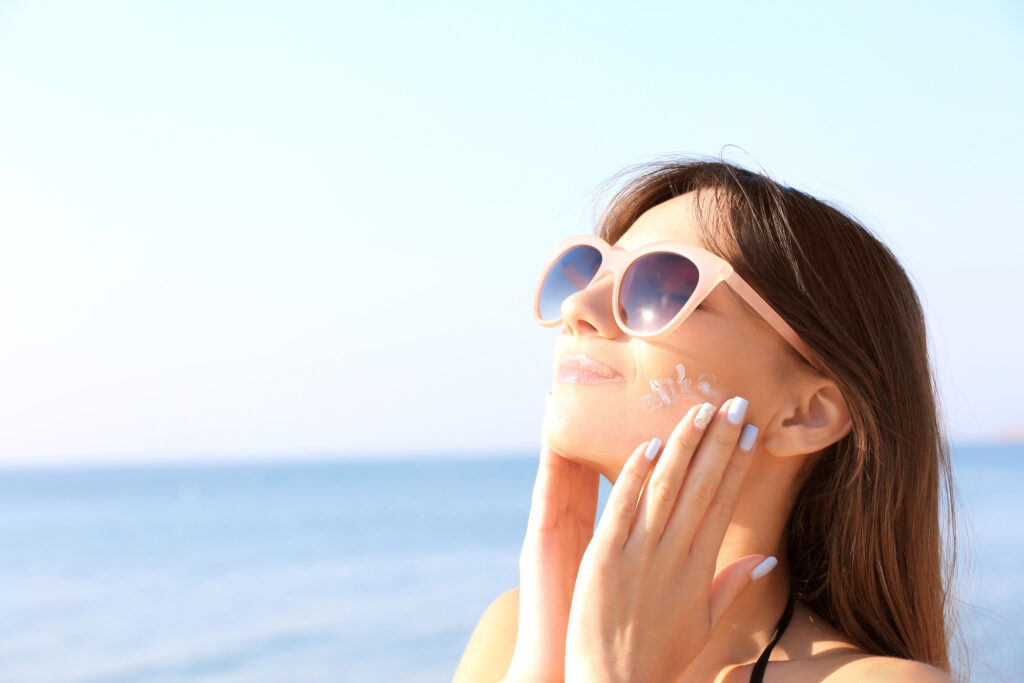
The skin is the human body’s largest organ. It takes 35 billion cells to cover the skin on the entire outside of the human body. The human body has 22 square feet (2 square meters) of skin, which is responsible for 8 pounds of body weight. Clearly, the skin is a massive organ.
By understanding the structure and function of the skin, you will be able to understand common skin conditions and how to prevent and treat them. Below we’ll dive into basic skin cell facts. We’ll include tips for supporting your skin, ingredients to look for and products (like this one and this one) that include ideal ingredients for keeping skin healthy.
Disclaimer: This post includes affiliate links, and we will earn a commission if you purchase through these links. Please note that We’ve linked to these products purely because we recommend them, and they are from companies we trust. There is no additional cost to you.
How many layers are in the skin?
Human skin consists of 3 main layers: the epidermis (outermost), dermis (middle), and fat/hypodermis (bottom-most). The thickness of the skin varies based on location. The back contains the thickest skin, while the eyelid has the thinnest skin.
What is the function of the skin?
The skin is responsible for many vital bodily functions and the overall health of the body. Here are some of the jobs it performs:
- Acts as a protective barrier against the outside world – Keeps pathogens, chemicals, UV light from Earth’s atmosphere, and allergens out.
- Retains moisture
- Produces Vitamin D
- Regulates body temperature
- Protects internal organs and entire body
Epidermis skin cell facts
The epidermis contains five layers: stratum corneum (outermost), stratum lucidum, stratum granulosum, stratum spinulosum, and stratum basale (bottom-most).
The epidermal layer, or the outermost layer of the skin, consists of several types of cells.
- Keratinocytes
- Melanocytes
- Langerhans cells
- Merkel cells
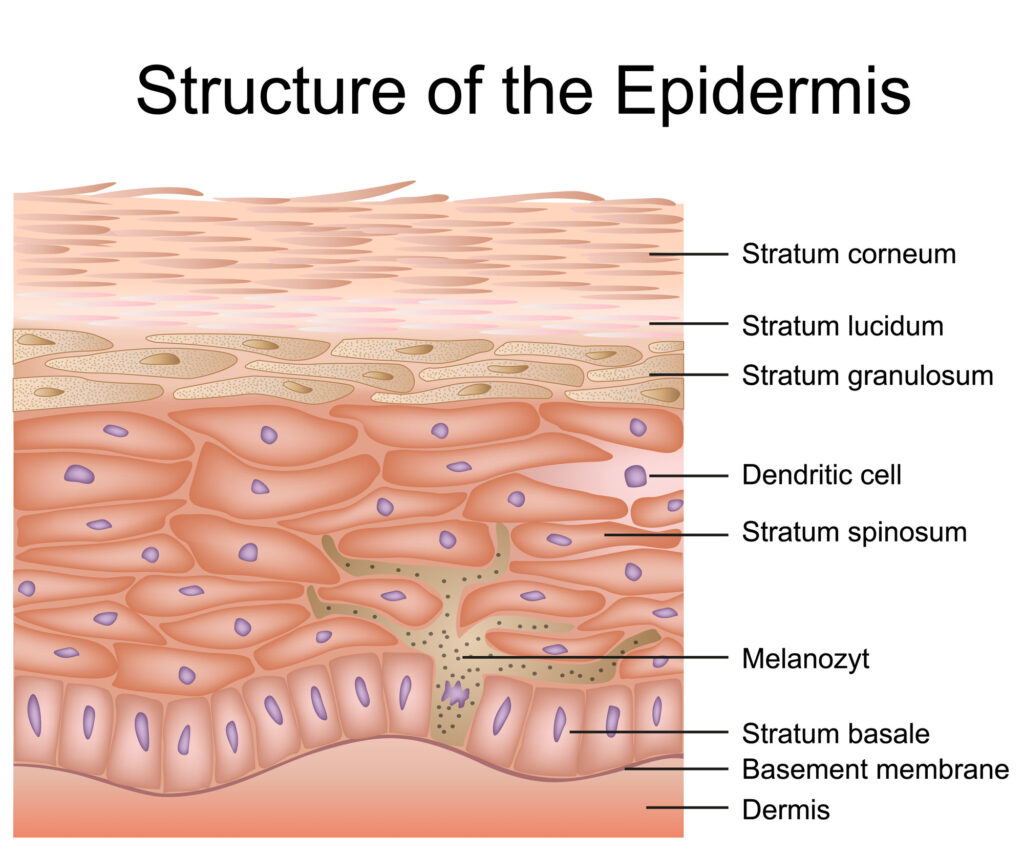
Keratinocytes make up the majority of the cells in the epidermis. They reside in every layer of the epidermis. New keratinocytes are “born” in the stratum basale and mature as they travel to the top of the epidermis in the stratum corneum.
By the time these new cells reach the stratum corneum (surface of the skin), they are no longer alive. These dead skin cells form a barrier to protect the living cells below. The epidermal barrier plays a vital role in keeping pathogens out to prevent infection and keeping water in to prevent dehydration.
Melanocytes are found in the stratum basale and produce a pigment called melanin. Melanin gives people their skin color. They are also responsible for age spots.
Langerhans cells live in the epidermis but are part of the immune system and our first line of defense. They determine what is a foreign allergen, then move eventually to the lymph nodes to report what they learned. Then your body can mount a response against the allergen to get rid of it.
Merkel cells reside in the stratum basale and are part of the nervous system. They are specialized cells responsible for touch sensation. There are many of them, especially in the palms of the hands and soles of the feet.
Dermis skin cell facts
The dermis contains two layers: papillary dermis (upper) and reticular dermis (lower). Several different cells inhabit the dermis as well as sebaceous glands (oil glands), blood vessels, nerve endings, hair follicles, and sweat glands. These cells can communicate with each other via chemicals (cytokines) they release.
- Mast cells
- Vascular smooth muscle cells
- Specialized muscle cells
- Fibroblasts
- Immune cells
- Inflammatory white blood cells: eosinophils, neutrophils, lymphocytes, and monocytes
Mast cells are a type of white blood cell. They contain granules full of histamine and other chemicals involved in allergic response and inflammation.
Vascular smooth muscle cells dilate and constrict blood vessels. They are involved in blood flow and temperature regulation. It keeps body heat in when you are cold and expels it when hot. Blood vessels deliver oxygen and nutrients to the entire body to nourish it.
Specialized muscle cells reside around sweat glands. They are responsible for releasing sweat to help regulate temperature.
Fibroblasts produce collagen and elastin, which gives the skin structure, elasticity, and plumpness. They are also responsible for scar tissue formation. Collagen and elastin form the connective tissue of the dermis.
Immune cells, like macrophages, recognize and remove foreign material.
Inflammatory white blood cells are involved in mounting an immune response to foreign material.
What is the hypodermis?
The hypodermis, also known as subcutis or subcutaneous layer, consists of fat cells (adipocytes). These fat cells store energy, insulate the body, and protect the other organs.
How to take care of skin cells to prevent disease

The easiest and most important way to care for the cells in your skin is by applying sunscreen. This protects them from UV damage from the sun. The radiation from the sun will lead to skin cancer formation.
At Wellness Trickle, we love Supergoop’s Play sunblock. It’s free from toxins, clean and water resistant for up to 80 minutes. It doesn’t leave white all over your face or body and goes on like a dream.
With exposure to enough radiation, the keratinocytes transform into cancers called Basal cell carcinoma and Squamous cell carcinoma. The Merkel cells can become malignant, developing into Merkel cell carcinoma.
Melanocytes turn cancerous and develop into Melanoma. Langerhans cells can be damaged by the sun also, leading to a problem with the immune system. When the sun causes immune system dysregulation, you will not be able to fight off pathogens or cancers.
UV radiation can also reach the dermis and destroy fibroblasts that make collagen and elastin. Over time, this will lead to wrinkles and sagging skin. When mast cells, inflammatory cells, and immune cells in the dermis are subjected to UV light, it promotes skin cancer formation.
Even fat cells can be damaged and destroyed by UV light from the sun. Without the fat, our body is less resilient to mechanical injury.
How to protect your skin cells every day
- Wear a broad-spectrum sunscreen to block UVA and UVB rays with at least an SPF 30 daily.
- Reapply sunscreen every 1-2 hours you are outside or driving in the car.
- Wear a wide-brimmed hat, sunglasses with UV protection, SPF 30 lip balm for your lips, and UPF clothing.
- Apply daily antioxidant serum with Vitamin C or E or both. The sun produces free radicals that destroy our collagen and elastin. Antioxidants will gobble up free radicals and protect your skin.
- Use retinoids to help repair the sun’s damage to the skin by stimulating collagen production by fibroblasts. Note: if you have rosacea, retinoids are not recommended.
- Use alpha-hydroxy acids, like glycolic acid, to help stimulate collagen production.
Without proper barrier function, you can lose water leading to dry skin. Dry skin is vulnerable to infection and irritation. Impaired barrier function may be one of the defects in patients with atopic dermatitis and rosacea. Because of the defective barrier, patients are susceptible to dry skin, irritation, redness, and infection. There are some topicals that you can use to help.
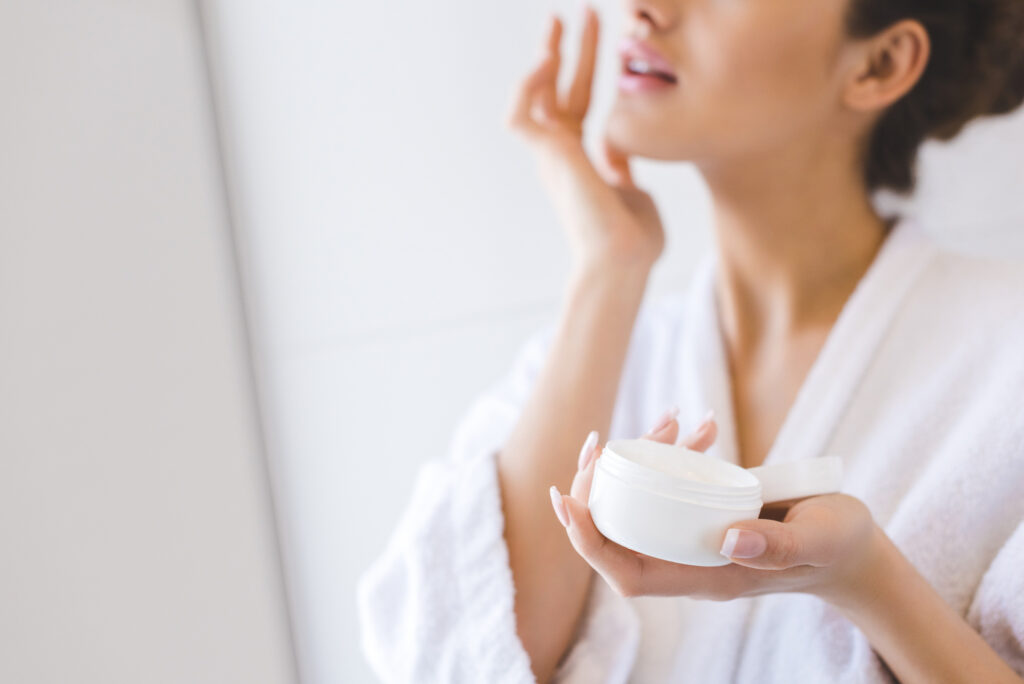
- Use moisturizer twice a day to prevent dryness.
- Make sure your moisturizer has a combination of humectants and occlusives. Humectants (like hyaluronic acid and sodium hyaluronate) will draw in moisture from the environment to hydrate the skin. Occlusives (like shea butter) will lock the moisture in and create a barrier to protect the skin from the environment.
- Occlusives may not be ideal for all rosacea or acne patients prone to breakouts because occlusive moisturizers can clog the pores making pimples worse. Select oil-free, non-comedogenic moisturizers if you have rosacea or acne.
- Moisturizers containing ceramides, niacinamide, and free fatty acids help restore the barrier. They are also safe for rosacea and acne patients.
- Look for soothing ingredients in your moisturizers, such as aloe vera or calendula.
- Anti-inflammatory plant oils can help soothe the skin, such as almond oil, jojoba oil, coconut oil, and argan oil. Some plant oils are comedogenic and will clog pores, such as coconut oil, and are not appropriate for use in patients prone to pimples.
- Cleanse the skin twice a day to get rid of dirt and bacteria.
- Use mild creamy cleansers that are not alkaline. Alkaline bar soaps degrade the barrier. Select products with a pH of 4.5-5.5.
The bottom line
Skin is the largest organ in the body and is critical to survival. Skin cells perform a vital role in our bodies by protecting our internal organs from harm. You must protect your skin and keep it healthy, so it can protect the rest of your body. It is our first line of defense against the outside world.
Take action
Start applying sunscreen today to protect your skin. Add antioxidants and other anti-aging products to your skincare routine. They can help prevent damage to your skin and premature aging.
Some Wellness Trickle favorites are anything from The Body Deli (especially the Sea Cucumber Gel and the Creme De La Rose) and the Renewing Night Serum by Hugh and Grace (honest review of Hugh and Grace products can be found here).
JENNIFER10 gets you 10% off your purchase at Hugh and Grace and WELLNESS_TRICKLE will get you 15% of your Body Deli purchase.
Aillea is also a great option for finding non-toxic products from many different brands.
Take proper care of your skin by washing twice a day and moisturizing twice a day with good ingredients. This is especially important if you suffer from skin conditions, like atopic dermatitis.
References
Bolognia, J, Jorizzo JL, Schaffer, JV. (2012). Dermatology. Philadelphia: Elsevier Saunders.
https://www.skincancer.org/skin-cancer-prevention/
https://www.aad.org/public/diseases/a-z/dry-skin-treatment
https://www.aad.org/public/diseases/eczema/types/atopic-dermatitis

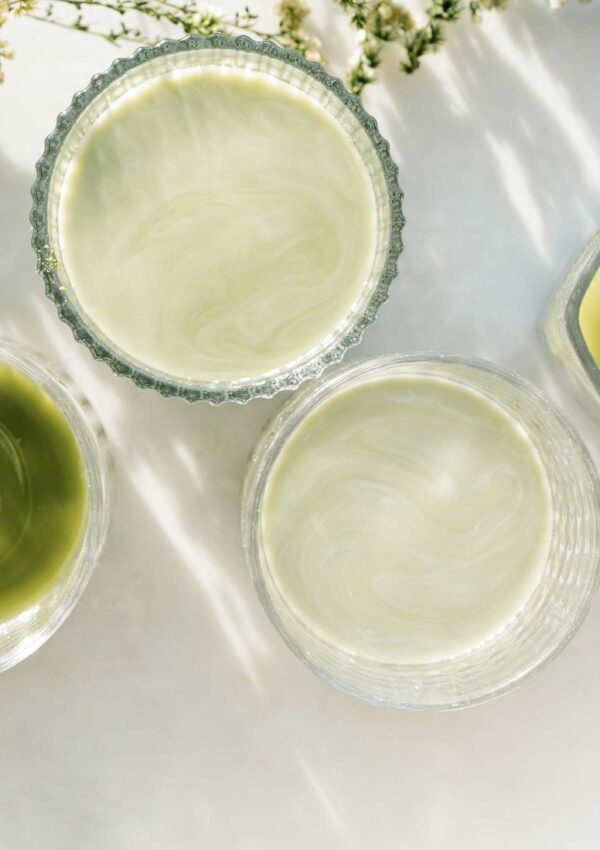

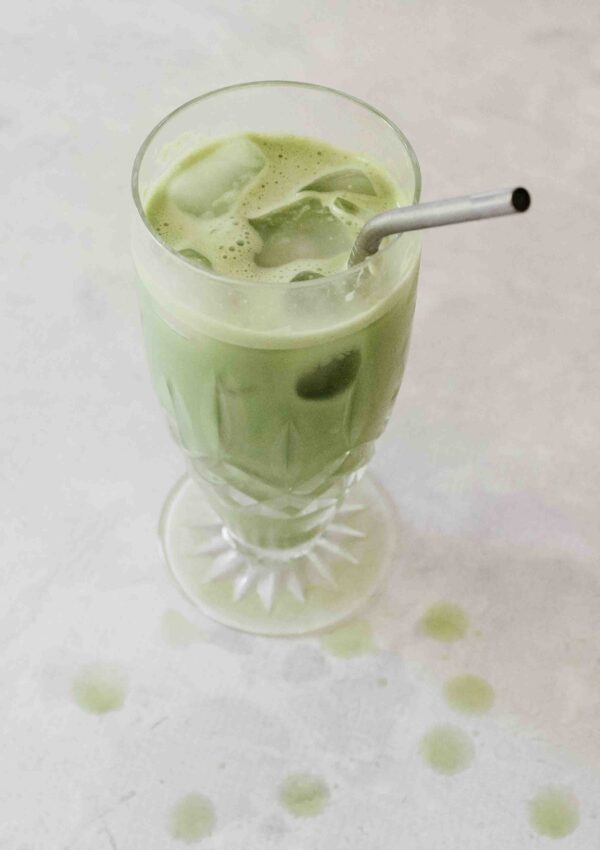

Leave a Reply